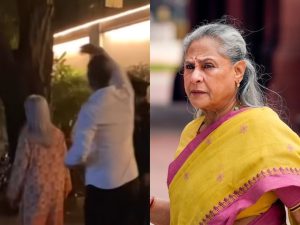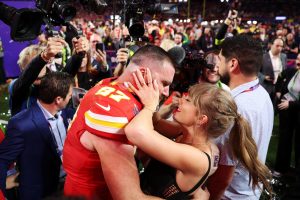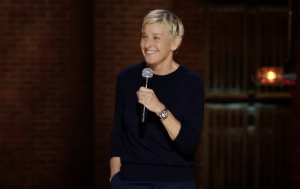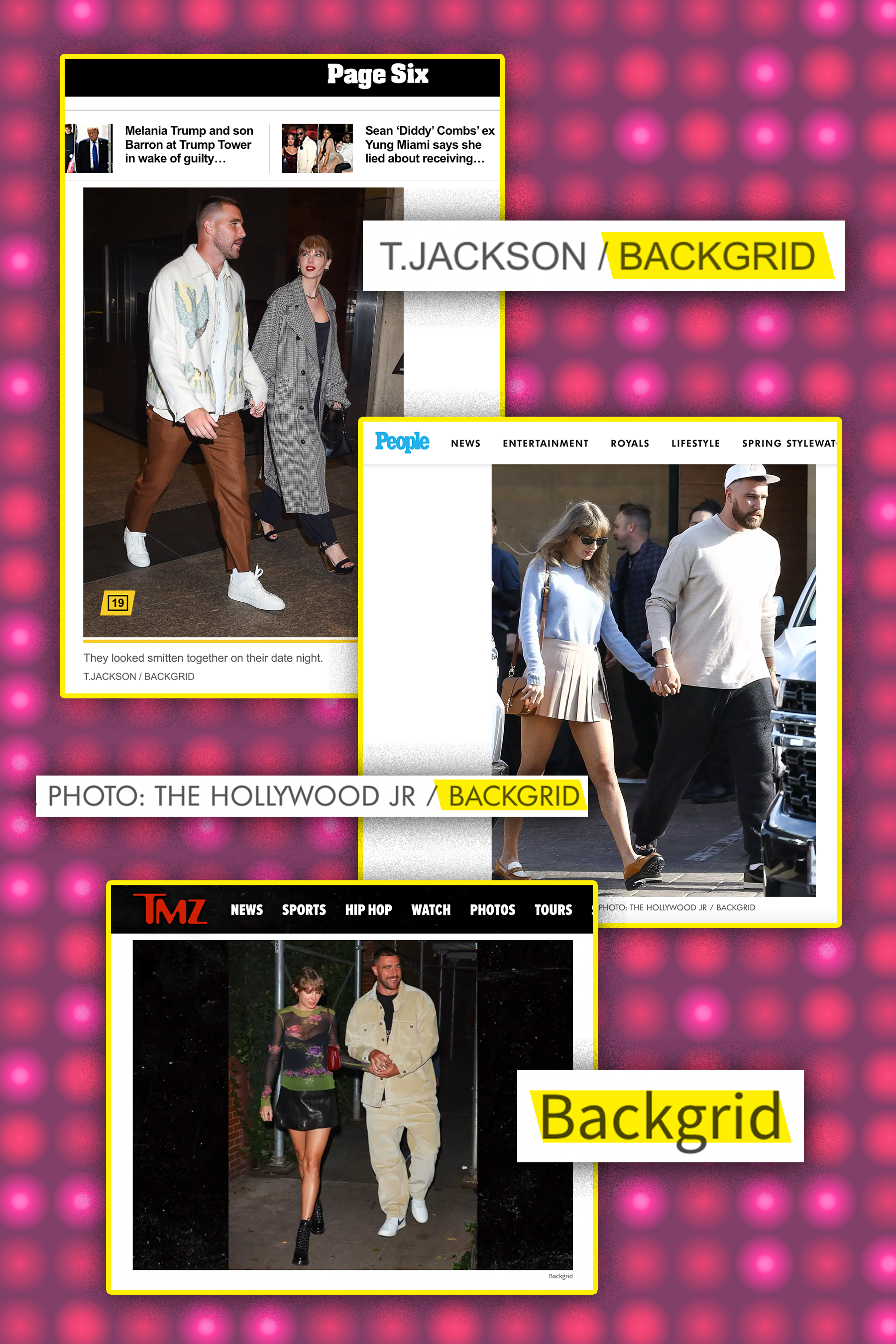
Between a series of failed projects, low concert sales, and a heavily scrutinized bodega order, it’s been a tough year for Jennifer Lopez. Two weeks ago, though, the negative PR surrounding her suddenly got worse. People magazine reported that Lopez and her husband Ben Affleck, the belabored subject of her most recent work, were experiencing problems. Another article mentioned that the couple, who’ve never shied away from cameras, had not been photographed together in 47 days.
Only a few hours later, Lopez and Affleck were suddenly spotted in the same place. Paparazzi photographed the two attending Affleck’s child Fin’s school play, holding floral bouquets. While there was no PDA, the couple looked cordial, engaging in conversation in the parking lot of the school. This immediately set off an alarm for a certain set of pop culture-inclined internet detectives, who are obsessed with calling out these kinds of presumably staged paparazzi photos. “I’ve never seen such an obvious pap walk in my life,” said one Tiktok user analyzing the photos. “They clearly called the paps on themselves,” said a skeptical commenter under another video.
For the suspicious, their concerns seemed confirmed when they noted the credit for the photos: Backgrid, a photo agency that’s been the subject of plenty of online speculation. Since its formation in 2017, the multinational photo agency has become an increasingly omnipresent force in tabloids and celebrity culture. While largely associated with the Kardashians, who are often accused of being in bed with the paparazzi, a wide range of celebrities — from Tom Cruise to Hilaria Baldwin — have appeared in photos and videos emblazoned with Backgrid’s orange watermark.
As a result, the organization has practically become a “weird gossip shorthand for PR setups,” says Kayleigh Donaldson, critic and writer of the Gossip Reading Club newsletter. This is especially true in the celebrity-focused corners of social media, where spectators take pleasure in overanalyzing coupling sightings and post-breakup outings and exposing their obvious, sometimes humorous inauthenticity. But is Backgrid actually the shadowy public-relations tool online sleuths have made it out to be, or has the way we observe celebrities in public changed?
What is Backgrid?
Over the past seven years, Backgrid has provided some of the most in-demand and newsworthy photos of Hollywood A-listers to tabloids and other publications since its launch. Writer Emily Kirkpatrick, who runs the celebrity fashion newsletter I <3 Mess, says Backgrid came across her radar in 2018 while working at Page Six, where there was a demand for “bikini pictures” and celebrities in “risque outfits.” “Every good photo, every viral photo, every photo you’d want to boost traffic was on Backgrid,” she says.
Co-founded by former paparazzo Steven Ginsburg, Backgrid is the product of a series of business acquisitions over the past decade. In 2008, Ginsburg launched his first photo agency called GSI Media. (In his bio on Backgrid’s website, he prides himself on being at “the epicenter of Charlie Sheen’s infamous meltdown” in 2011.) And in 2017, AKM-GSI Media merged with Scott Cosman’s FameFlyNet to officially become Backgrid. Also joining the founding team, Dan Taylor, formerly of Xposure Photos, helping to establish the agency’s foothold in the UK. This past February, Backgrid was acquired by Shutterstock.
According to its website, the agency “supplies the world’s top news outlets with real-time content from the world’s top photographers.” It serves the same function as other photo-hosting sites like Getty Images, the Mega Agency, and Splash News, which is also owned by Shuttershock. As many other photo agencies do, it purports to have a standard freelance relationship with paparazzi, “a contributor pool [that] includes over 1,000 photographers from around the world.” (Backgrid did not respond to Vox’s request for comment.)
A testament to its ubiquity, Backgrid is credited on nearly all photos and videos of pop culture’s latest power couple Taylor Swift and Travis Kelce, from one of their first New York outings at Nobu NYC to their romantic getaway earlier this month Lake Como in Italy. Other photos of famous couples, like The Bear star Jeremy Allen White and singer Rosalía, are hosted on its site, as are a number of Rihanna and A$AP Rocky sightings. The viral photo of Lopez and Affleck re-creating a steamy moment from Lopez’s “Jenny From the Block” video also belongs to Backgrid, too. Arguably their biggest get this year was a grainy image of Kate Middleton riding in the passenger’s seat of an SUV, her first public appearance following her abdominal surgery this past January.
By all accounts, Backgrid’s operations aren’t unique. However, on social media platforms like Reddit and TikTok — where conspiracy theories are known to thrive — there seems to be a false understanding of how Backgrid and the paparazzi work and their relationships with celebrities.
“The common misconception a lot of people have about Backgrid is that they’re actively sending photographers out to certain events and dictating who is photographed and where,” says Donaldson. Ostensibly, this assumption has something to do with the paparazzi’s association in the 21st century with outlets like TMZ and the Daily Mail, which employ their own photographers. However, Donaldson says that “most photographers in the field are freelance.”
The majority of users’ concerns, though, is not if Backgrid is dispatching photographers, but if celebrities are arranging photoshoots directly with Backgrid.” Presumably, this has something to do with the particular faces users have noticed repeatedly in their photos. (Although, again, the agency hosts content featuring a wide range of public figures.)
Many of these Backgrid staples are already conspiracy magnets on Reddit and other online forums or have reputations for engaging in publicity stunts, such as with the Kardashians, Kanye West, Hailey Bieber, and former controversial couple Harry Styles and Olivia Wilde. Photos of Vanderpump Rules stars during last year’s Scandoval also raised questions about the authenticity of these celebrity sightings, given the cast’s D-list celebrity status.
Unsurprisingly, Meghan Markle and Prince Harry are two other big names, frequently found at the center of online theories, who have become associated with Backgrid. Last May, Meghan and Harry got into a tiff with the agency after they demanded the agency hand over photos that freelance photographers took during an alleged car chase in New York. While the couple’s spokesperson described the chase as a “near catastrophic” incident, New York police didn’t report any collisions or injuries.
Backgrid denied the couple’s request with a cheeky statement. Nevertheless, it hasn’t stopped the agency from obtaining photos of the couple, particularly Markle, who’s been snapped stepping out in their new hometown of Montecito. This has caused speculation, if not full-blown conspiracy theories, on Reddit about her relationship with paparazzi and the agency.
“Since she and Prince Harry moved back to Montecito, she gets photographed on sort of regular intervals,” says writer Allie Jones, who runs the newsletter Gossip Time. “And there’s not a huge paparazzi presence in Montecito. So when she does get photographed, it’s sort of like, how did that happen?’”
The paparazzi’s reputation has changed since the days of Britney Spears and Amy Winehouse
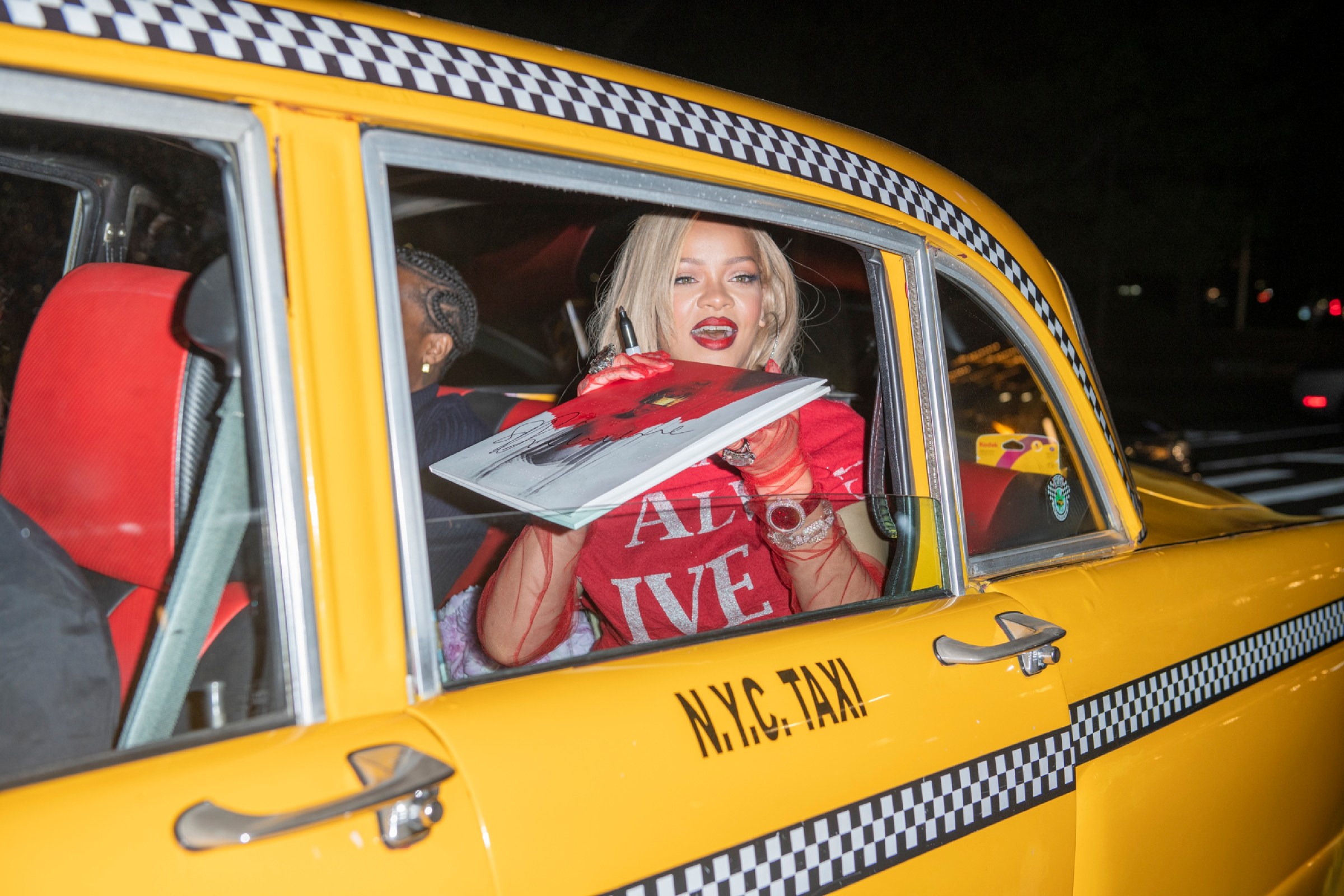
Speculation about Backgrid and the source of other paparazzi photos feels indicative of a post-social media world that, as Donaldson puts it, has become “more knowledge about the labor of being famous.”
“In the era of social media and structured reality series like the Bravo shows, where everything is openly set up and audiences are let in on the process, there’s far less mystique,” she says.
During the heyday of TMZ and other tabloids in the early and mid-2000s, much of the chatter surrounding paparazzi photos stopped at how the celebrities looked and what they were doing in the photos. Take US Weekly’s popular column “Stars — They’re Just Like Us!,” for example, which captures famous people doing mundane activities or suffering embarrassing faux pas. Now, though, this street-style photography has become more glamorous and professional-looking. Likewise, it seems that fans are now focused on whether or not these photos are orchestrated and what messages celebrities are trying to convey through them.
The reputation of paparazzi has changed drastically and in a relatively fast manner over the last decade. Since the profession’s origins in 1950s Italy, the stereotypical image of paparazzi has been one of invasive, aggressive, and greedy men, desperate for a scandal and willing to get a picture at all costs. Likewise, this ravenous behavior often demonstrated by paps have led to many notable altercations with celebrities, including Kanye West, Alec Baldwin, Hugh Grant, Amy Winehouse, and Britney Spears. The most infamous example of the paparazzi’s reckless pursuits was the death of Princess Diana in 1997, following a car chase with photographers.
Throughout the 2010s, these clashes have become less common, in part because the role of paparazzi in the media landscape has lessened. Following the Great Recession, many photo agencies, as well as magazines, consolidated. Most of these companies have also adopted subscription models, which magazines pay for — so rather than receiving a lump of cash per photo, photographers are offered a small fraction of a subscription fee based on how many of their photos are used each month. Plus, the explosion of social media — where users upload their own celebrity sightings or send them to gossip accounts like Deuxmoi and celebrities produce their own images — has naturally decreased the novelty of these photos.
That’s not to say that paparazzi don’t hold any value in our current culture — as the ubiquity of Backgrid has shown. More accurately, the predatory dynamic between photographers and celebrities has shifted in many cases. While they were once celebrities’ main adversaries, photographers, and photo agencies have become extensions of their PR teams.
Publicist Monique Tatum is the CEO of Beautiful Planning Marketing and PR, which serves “A- and B-level celebrities and stylists” among other industry figures. She says that it’s practically standard for “publicists to call paparazzi for clients and client events.” She also notes that many of her clients have their own photographers on staff.
“More often than not, photos, news stories, and celebrity beef are planned publicity stunts or behind-the-scenes publicity maneuvers,” she says, adding that strategy is often “thought out for months” in advance. “There’s a line item in that plan and a date for someone to call paparazzi or tip them off to get press rolling,” she says.
Celebrities, like Lopez, will often deny these planned photo shoots. But other stars, like Kim Kardashian, have been less conspicuous about their relationships with paparazzi. For example, the beauty mogul has admitted to calling the paparazzi on herself early in her career to gain more attention. Former Splash News CEO Gary Morgan has also opened up about his previous (and contentious) relationship with Kardashian and her personal photographer.
Rihanna is also known to engage in this form of PR trickery. When the singer-turned-entrepreneur announced her first pregnancy via a glamorous pap stroll in Harlem with her partner A$AP Rocky, the photos were taken by her frequent collaborator Miles Diggs a.k.a. Diggzy, and sold to Shutterstock. Diggs has also made a name for himself in this regard, maintaining relationships with other A-listers like Hailey Bieber and Cardi B. Most of his photos capture his subjects showing off — if not advertising — designer fashion.
“They’re notably more glamorous and flawless,” Kirkpatrick says. “The paparazzi I’ve talked to are always like, ‘Is there anyone in the background of the photo? Is there anything like blocking them in the foreground? Are they looking dead at the camera? Okay, that’s a setup.’”
In the social media era, paparazzi photos are more powerful than ever before
While the media landscape has certainly changed for photographers and how they make their livelihoods, paparazzi photos still hold a firm value for celebrities in conveying a level of status and glamour that’s become democratized in the digital era. For actual A-listers, it allows them to stand out in an attention economy that’s shared with an increasingly wide pool of public figures, from YouTubers to Twitch streamers to model influencers to Congress members.
“It reaffirms your own fame,” Kirkpatrick says. “It’s a very old-school idea of celebrity and how fame works, but I think it’s still a very operational one and one that celebrities still really value.”
For minor celebrities, paparazzi photos telegraph a level of public interest that may not actually exist, or might at least be overexaggerated. Reality stars, in particular, seem to be some of the worst offenders of the staged pap walk. “Some reality stars live on the text chains with paparazzi, as do some publicists,” says Tatum.
Still, Allie Jones argues that being able to call the paparazzi on yourself is its own flex. “The agencies and photographers would never set up a staged photo if they didn’t think it was going to sell,” says Jones. “If we’re talking about Lala Kent from Vanderpump Rules, obviously, there’s enough interest in her life, even though she’s not Julia Roberts.”
With all this transparency and public knowledge about celebrity PR setups, one wonders if all the fun or, more precisely, mystique, has been removed from observing celebrities in public. For instance, when Kylie Jenner and Timothée Chalamet were first seen together as a couple, social media immediately decided that the two were in on some Kris Jenner-orchestrated scheme to boost Jenner’s profile. Others saw it as an attempt to promote Chalamet’s upcoming movies. In general, since the pandemic, there’s been a heightened interest in the “PR relationship” and all the image-curating that goes along with it.
While Kirkpatrick thinks it’s important for people to be “media literate,” she thinks it might be time for social media users to “scale back” on their immediate skepticism. “We need some discernment,” she says. “You really think two hot people who are rich couldn’t possibly find each other and fall in love?”
Donaldson agrees that we still haven’t found a “happy medium” between understanding how celebrity works and the fact that “not every photo is a nefarious setup.” In other words, the questions surrounding Backgrid aren’t totally off-base. But they demonstrate an online impulse to address anything slightly fishy with conspiratorial thinking.
“Sometimes a celebrity just gets photographed because they’re famous, and sometimes they want to be photographed to remain famous,” she says. “That’s not the conspiracy of the century.”

